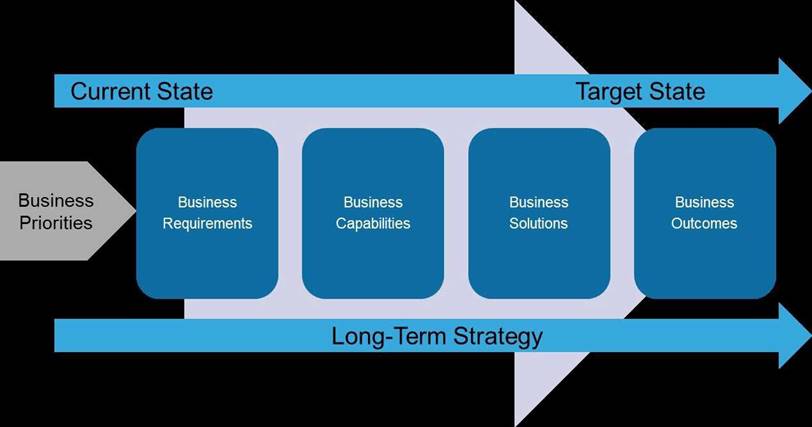- All Exams Instant Download
Which factor encompasses the standards and cultural behavior that are important to the business?
Which factor encompasses the standards and cultural behavior that are important to the business?
Mission
Values
Strategy
vision
Answer: B
Explanation:
In an effort to fully understand the business, it is imperative to be able to articulate the factors that drive the business strategy. The business priorities establish the direction for the business and determine the business outcomes to be achieved from the strategy. The business requirements, business capabilities, and business solutions enable the business to move from its current to its target state business model.

In addition to defining the business priorities, requirements, capabilities, solutions, and outcomes it is important to understand the additional factors that drive the target state of the business.
Values: Values encompass the standards and behavior that are important to the business. Values are important to understand from a business architecture perspective because the organization is a personification of its values. The business values influence how individuals within an organization
perceive the purpose of the business. Business values vary across industry verticals and public and private sector organizations.
Mission: The mission defines the purpose of the organization. Similar to the values, the mission will vary across industry verticals and public and private sector organizations.
Vision: A vision is an overall picture of the target state of the business. Depending on the organization, there can be an overarching vision statement or each organization within the business can have a vision statement. A vision statement is not detailed in nature. The vision statement sets the framework for strategic planning. An example of a vision statement is a manufacturing company desiring to be the top steel provider in the world in the next five years. A vision statement is not detailed.
Strategy: A strategy is a long-term plan that enables the business to work toward achieving its vision and is aligned with the values and mission of the organization. A strategy is based on the business goals and objectives that support the business priorities. A strategy is a map of how the business will move from point A to point B. The strategy considers the business operations, value proposition, customers, and finance. The goals and objectives enable the business to measure its progress toward executing on the strategy.
Goals: Business goals determine what the business wants to accomplish as part of its strategy. Using the manufacturing company that was mentioned earlier, one goal could be to acquire smaller steel manufacturers to build upon existing capabilities. Another goal may be to develop strategic partnerships with key suppliers. Metrics are associated with goals. There will be specific time lines for each of the previous examples.
Objectives: Business objectives are more specific and often have shorter time lines than goals. Business objectives are components of business goals. A business objective for the steel manufacturing company may be reducing operational costs by 5 percent over the next six months. Another objective may be to develop three new strategic partnerships by the end of the next fiscal year.
The SMART framework is used to define effective objectives:
S: Specific
M: Measurable
A: Achievable
R: Realistic
T: Time bound
Latest 810-440 Dumps Valid Version with 269 Q&As
Latest And Valid Q&A | Instant Download | Once Fail, Full Refund
Subscribe
Login
0 Comments
Inline Feedbacks
View all comments

